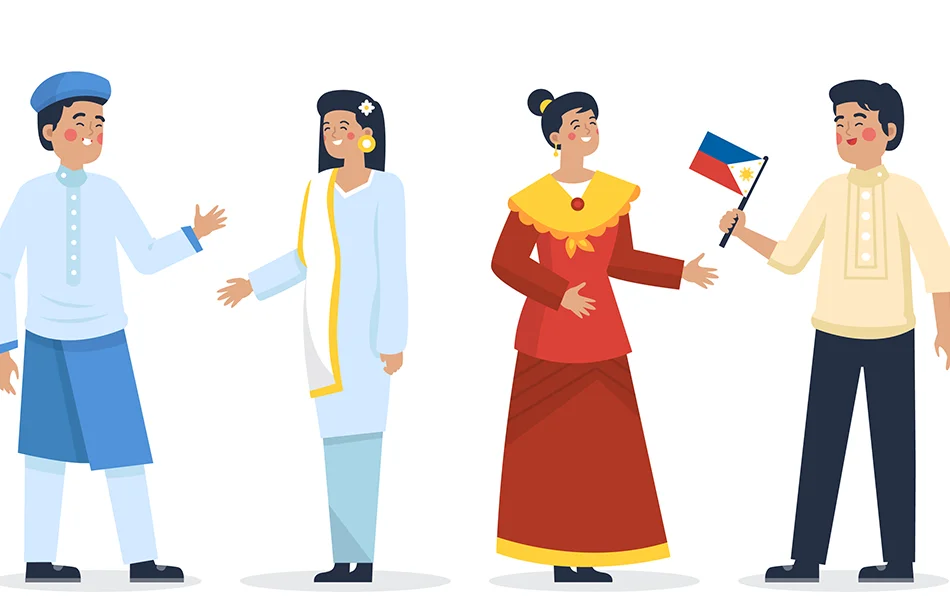The Philippine culture is noted for its rich history and legacy, as well as its unique traditions and rituals. Philippine culture is one of the most diverse and fascinating in the world, with its particular practices and traditions. It has melded with diverse cultural influences, from its ancient tribal roots to its colonial history, creating a unique blend that has attracted foreigners for decades. From vibrant festivals to a distinctive cuisine, Filipino culture displays a fusion of Southeast Asian, Spanish, and American influences. It is a culture worth investigating and experiencing because it reveals the country’s identity and ideals. Immersing oneself in Philippine culture, known for its warm hospitality and inviting people, is a way to experience something authentic and new, making a difference and adding value to one’s daily life.
Discovering Philippine Culture: Understanding the Basics

Filipino society, as well as Filipino values and culture, are the result of the country’s unique past, which dates back thousands of years. A substantial element of Filipino society, values, and culture may be traced back to indigenous roots, which differ depending on the area. The Philippines also has a lengthy history of invaders, from the Spanish to the Americans, who have left an unmistakable mark on Filipino values, culture, and way of life. This can be observed in the language, cuisine, customs, and traditions of the country. The Philippines has a rich history spanning four centuries, and many changes and advancements have molded Filipino ideals, Filipino families, and Filipino culture.
Aside from the history of colonization, important historical events such as the People Power Revolution in 1986 affected the country’s culture. The revolution was a historic event that served to unite the country and resulted in socio-political change that is still felt by the Filipino people today. The Filipinos are noted for their gracious hospitality, courtesy, and regard for others. Filipinos place a strong priority on family values, and close-knit, extended family ties are frequent. Strong religious views are also an important aspect of Philippine society, with Catholicism reigning supreme.
Festivals are an important part of Philippine culture, with numerous held throughout the year. These celebrations are vibrant and vivacious, and they frequently feature traditional dances, music, and costumes. The Philippines is particularly well-known for its distinct cuisine, which combines flavors and ingredients from numerous cultural influences. Adobo, sinigang, and lechon are among the well-known dishes. The culture of the Philippines is a fascinating blend of numerous influences that have resulted in a rich and distinct character. It is a culture worth learning about and experiencing since it reveals information about the country’s history, values, and practices.
The Roots of Philippine Culture
Philippine culture can be traced back to the pre-colonial period. Prior to the introduction of foreign powers, the Philippines was populated by various ethnic groups, each with its own languages, distinct culture, and customs. These distinct ethnic groups had their own languages, beliefs, and practices that were passed down from generation to generation from extended family to extended family to members and members from extended family.
Spanish colonialism had a tremendous impact on Philippine culture in the 16th century. The Spanish brought Christianity to the Philippines, which became the dominant religion. They also brought their own language, customs, and rituals with them, which melded with the local culture. As a result, a distinct synthesis of Catholicism and indigenous beliefs developed, which may still be reflected in Philippine society today.
In the early twentieth century, the Philippines was likewise under to American colonial rule. This resulted in other cultural exchanges and impacts, such as the widespread use of English and Western-style education. Today’s Philippine culture reflects the country’s rich history and influences. Filipinos have embraced their cultural heritage while adding features from other cultures. This can be evident in the music, art, literature, and fashion of the country.
Philippine culture’s roots have shaped the country’s traditions, official language, beliefs, and values. They have also paved the way for the development of distinct cultural expressions, making the Philippines a vibrant and diverse place to visit. Understanding the foundations of Philippine culture is essential for appreciating its rich legacy and the country’s ongoing progress.
A closer look at Philippine Traditions and Customs
The culture of the Philippines is rich and diverse, with customs and traditions profoundly anchored in the country’s history and the different indigenous communities who have inhabited the archipelago. Some of the most fascinating and noteworthy traditions and rituals that are still observed today are as follows:
1. Bayanihan
This Filipino value denotes a sense of community, cooperation, and mutual assistance. It is frequently seen in both rural and urban places, as people come together to aid a neighbor in need or to work toward a common goal.
2. Balikbayan boxes
Filipinos working overseas frequently send large packages containing clothes, toys, and other gifts to their family back home. These boxes are known as balikbayan boxes, and they represent the Filipino culture’s sense of filial commitment to extended family and family members and family members and extended family and members and generosity.
3. Catholicism
With more than 80% of Filipinos being Catholic, Philippine culture has a major Catholic impact. This religious tradition is represented in the fiestas, processions, and other religious events held throughout the country.
4. Pagmamano
As a symbol of respect and reverence, this gesture entails putting one’s forehead into the hand of an elder. It is a ritual that is still prevalent in the Philippines, particularly in rural regions.
5. Food culture
Filipino cuisine combines Malay, Spanish, Chinese, and American influences. Traditional Filipino meals such as adobo, sinigang, and lechon are household mainstays that are frequently offered on important occasions. Balut is another traditional Filipino dish prepared from fertilized duck eggs that have been boiled alive while still in their shells. Because of its high protein content, it is said to be an ancient fertility symbol, but it has also become a popular snack item throughout the country. Balut can be eaten alone or paired with other flavors such as onions, garlic, tomatoes, chili peppers, lemongrass, and ginger.
These are only a few instances of the vibrant traditions, martial arts, and rituals that distinguish Philippine culture. Understanding and respecting these rituals is a crucial element of experiencing and immersing oneself in this wonderful country’s rich heritage.
Iconic landmarks and attractions
The Philippines is home to a wide range of renowned monuments, commercial buildings, and tourist attractions, each with its own distinct characteristics and historical significance. These sites would captivate any visitor, from the beautiful Chocolate Hills in Bohol to Cebu’s Magellan’s Cross.
1. Chocolate Hills
The Chocolate Hills in Bohol are one of the Philippines’ most recognizable landmarks. The hills are a one-of-a-kind structure of roughly 1,700 grass-covered limestone mounds ranging in height from 30 to 120 meters. During the dry season, these hills turn brown, hence their name. The Chocolate Hills are a National Geological Monument and one of the most popular tourist attractions in the country.
2. Mayon Volcano
Mayon Volcano, located in Albay province near Legazpi City, is another renowned tourist destination. This active stratovolcano with an almost perfect cone shape stands 2,462 meters tall. It is widely regarded as one of Asia’s most magnificent volcanoes and has been a national park since 1938.
3. Puerto Princesa Underground River
Another natural wonder worth seeing while in the Philippines is the Puerto Princesa Underground River. This 8km underground river on Palawan Island travels through a beautiful limestone cave system before spilling into the South China Sea. Because of its ecological variety and subterranean characteristics such as waterfalls and rock formations, it has been listed as a UNESCO World Heritage Site since 1999.
4. Tubbataha Reefs Natural Park
Tubbataha Reefs Natural Park is another option for nature lovers wishing to discover the Philippines’ marine life. This UNESCO World Heritage Site protects over 33,000 hectares of coral reef systems that are home to endangered species and an astounding diversity of animals such as whale sharks, turtles, manta rays, dolphins, and over 500 types of fish.
5. Magellan’s Cross
Magellan’s Cross is significant in Philippine history since it was established by Portuguese explorer Ferdinand Magellan upon his arrival on Cebu Island in 1521, making him the first European explorer to reach Philippine shores! This wooden cross commemorates Magellan’s first contact with Filipinos, which triggered centuries of Spanish dominion in this area of Asia until 1898 when American forces seized control of parts of what is now known as the Philippines. Visiting these renowned landmarks can help visitors gain a better understanding of Philippine culture and history while also providing insights into some of the country’s most unique locations.
The importance of preserving Philippine culture
It is impossible to stress the importance of preserving Philippine culture. The country’s history, traditions, and customs are an important component of its identity, and they help to shape the unique character of its people. Here are some of the reasons why it is critical to preserve Philippine culture:
1. Cultural heritage
Philippine culture is a rich mine of art, literature, music, and dance that exemplifies the Filipino people’s originality and ingenuity. By preserving this heritage, future generations will be able to enjoy and learn from it.
2. National identity
The culture of the Philippines is a source of national pride and identity. The country may keep its individual character and advertise itself as a vibrant and diversified tourism destination by preserving its customs and traditions.
3. Community cohesion
The conventions, official language, and traditions that constitute Philippine culture also assist to enhance personal interactions and links among various ethnic groups and communities in the country’s urban areas. These common rituals and beliefs foster a sense of belonging, self-esteem, and unity, all of which are necessary for a cohesive and stable community.
4. Economic impact
The preservation of Philippine culture can also benefit the economy. Many traditional products, like handicrafts and textiles, are popular with tourists and can help local communities earn money.
5. Environmental conservation
Many Philippine traditions entail a reverence for nature and the environment, such as the use of natural materials in handicrafts, the preservation of marine and forest ecosystems, and the use of natural resources in staple foods. The country may encourage sustainable growth and conserve its natural resources for future generations by conserving these customs.
Individuals, communities, and the government must all work together to preserve Philippine culture and the official national language. By recognizing and preserving its customs, language, and traditions, the country may ensure that its rich history remains a source of pride and inspiration for future generations.
The Role of Education in Preserving Philippine Culture
Education is crucial to the preservation of Philippine culture. Both private schools and colleges can help students comprehend the relevance of their cultural heritage and build pride in their identity as Filipinos by including cultural studies in the curriculum.
First and foremost, education may aid in the preservation of Philippine culture through increasing cultural knowledge and appreciation among youth. Students can learn about the contributions of Philippine culture to world civilization and gain a deeper awareness of the values and traditions that form their personal relationships and communities via studies in history, literature, and the arts. Furthermore, education can be used to transmit information and abilities linked to traditional arts and crafts. Students can learn about the procedures and materials used in weaving, ceramics, and other crafts by adding hands-on activities into the curriculum, which can help conserve these talents for future generations.
Education also plays a vital part in sustaining Philippine culture by promoting cultural variety and inclusivity. Students can acquire a more open-minded and sympathetic attitude toward individuals of diverse backgrounds by emphasizing the need of understanding and accept cultural diversity, which can help promote peaceful and harmonious communities.
Higher education can promote environmental conservation and natural resource protection, which is an intrinsic part of Philippine culture. Schools and universities may help build an environmental awareness culture that benefits both the local community and the globe at large by teaching students about the necessity of sustainable development and responsible environmental stewardship.
Education is critical to the preservation of Philippine culture. Education can help ensure that the rich heritage of Philippine culture is passed on to future generations in all its glory by promoting cultural awareness and appreciation, transmitting traditional knowledge and skills, promoting cultural diversity and inclusivity, and encouraging environmental conservation.
Recognizing and Celebrating Philippine Culture
Recognizing and enjoying Philippine culture is an important step toward ensuring its survival for future generations. Through numerous cultural activities, festivals, and events, it is vital to highlight the richness and diversity of Philippine customs.
The development and preservation of traditional arts and crafts is one of the most important methods to recognize and appreciate Philippine culture. Traditional crafts such as weaving, ceramics, woodcarving, and others are important manifestations of Philippine culture and tradition. Visitors can learn about the history and practices of these traditional arts by viewing these crafts in museums, galleries, and cultural centers.
Festivals and cultural events are also good ways to commemorate Philippine culture and traditions. Cultural events that honor and celebrate tradition include the Ati-Atihan Festival, Sinulog Festival, and Kadayawan Festival in the Philippines. These festivals showcase the diversity and complexity of Philippine culture via traditional dances, music, and costumes.
Traditional cuisine is another essential method to acknowledge and appreciate Philippine culture. Philippine food is diverse and tasty, influenced by many different locations and civilizations. People can learn about the history and skills of traditional Philippine cooking, as well as savor the flavors and smells of this treasured cuisine, through food festivals and cooking lessons.
Recognizing and appreciating Philippine culture entails recognizing the achievements of notable Filipino artists, writers, musicians, and performers. Through exhibitions, performances, and prizes, Filipinos’ ability and ingenuity in numerous sectors must be showcased and their legacy honored.
Discovering the rich heritage of Philippine traditions, official languages, staple foods, and customs is an entertaining and enlightening experience. The Philippines has a broad assortment of traditions, official languages, and customs that reflect its fascinating past and unique combination of influences.
By studying Philippine culture more closely, we can obtain a better knowledge of what makes this country unique and enjoy the beauty and richness of daily life and traditions. We can celebrate and conserve Philippine culture for future generations by researching traditional arts and crafts, attending cultural events and festivals, delighting in traditional cuisine, and recognizing the accomplishments of Filipino artists.
So why not visit the Philippines and immerse yourself in its vibrant and diverse culture? If a journey isn’t possible, delve into literature and online resources to discover more about this intriguing country’s rich background. Whatever you do, make every effort to cherish and honor Philippine culture, both for its own sake and for future generations.
Written by Sarah Mae Estrella





